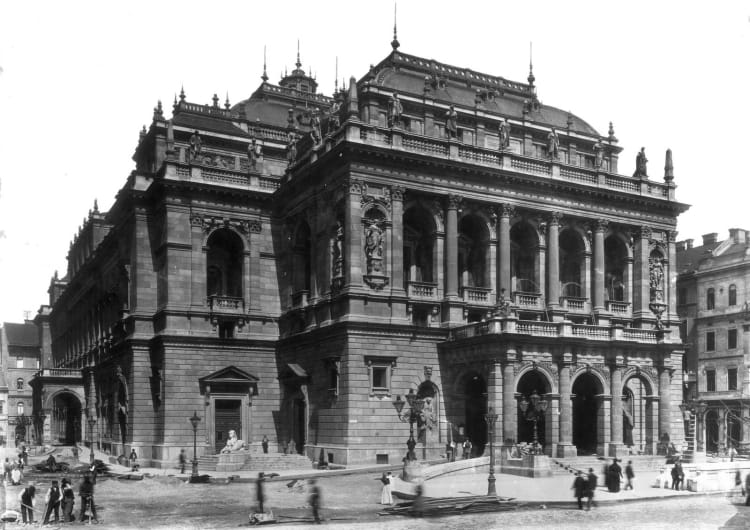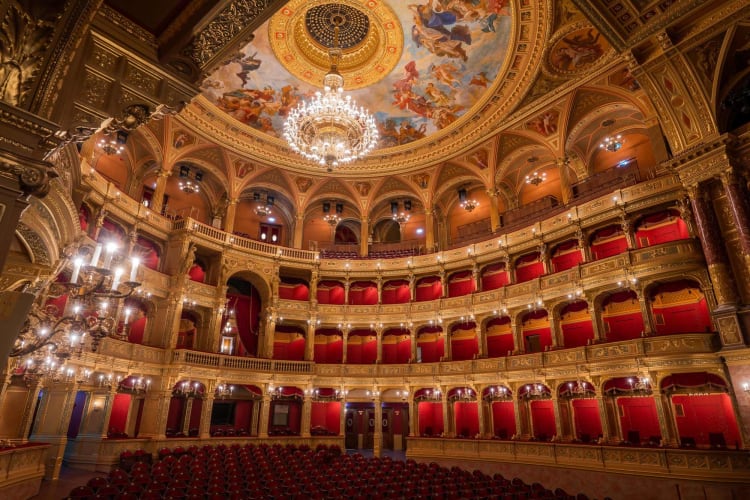
“I forgot to say, it can’t be more beautiful, either”
One of the most significant architectural monuments of the city, the Hungarian State Opera House, designed by Miklós Ybl and built in the neo-Renaissance style, was the most modern building of its time.
Learning from the tragic fire at the Ringtheater in Vienna in 1881, Ybl increased the number of emergency exits and had independent staircases built for every floor. He pioneered the use of sprinkler-systems, cast-iron stage machinery, as well as a number of new technical innovations, including the use of set pieces moved from above instead of coulisses.
Although Emperor Franz Joseph I. (Emperor of Austria and King of Hungary) supported the building of an opera house in Budapest, he stipulated that it could not be bigger than the one in Vienna. Legend says that at the grand opening on 27 September 1884, he said: “Indeed it is not bigger, but I forgot to say it cannot be more beautiful, either.”
In 2022, after a full reconstruction, the hub of Hungarian opera and ballet was reborn, its magnificent interior having regained its former glory. The most striking features of the facade are the two sphinxes carved out of Carrara marble, and the large statues of Franz Liszt and Ferenc Erkel. The decorations in the lobby replicate the facade design’s main motifs: depicting the relationship between Hungarian and European music.
The main staircase with its gold coffered, mirrored ceiling, its beautiful lines and balustrades arranged in a unique spatial composition. The flights of the main staircase lead from the two sides of the lobby straight to the ground floor entrance of the auditorium.
The horseshoe-shaped, three-storey auditorium decorated with Károly Lotz's monumental dome fresco entitled The Apotheosis of Music, and the chandelier designed by Miklós Ybl, create a breathtaking spatial experience. The Royal Staircase leading to the salons on the first floor was once used by Franz Joseph and Queen Elisabeth, affectionately known as Sissi. In addition to the box in the auditorium reserved exclusively for the royals, they had their own salon and Sissi even had her own secret entrance.
The so-called smoking corridors, decorated with oak panels and blue and gold upholstery, provide a great place for socialising. You can enjoy lunch or dinner at the elegant Opera Café, and buy a little Opera souvenir at the Shop. Visitors interested in architecture and culture can enjoy guided tours in English as well.
The rich repertoire and the illustrious roster of artists of the Opera, which is also home to the Hungarian National Ballet, is the pride of Hungarian culture. Many Hungarian works have premiered within these historic walls, including for example Bluebeard’s Castle and the Wooden Prince by Béla Bartók, Háry János and Székelyfonó (The Spinning Room) by Zoltán Kodály, Vérnász (Blood Wedding) by Sándor Szokolay, C’est la guerre by Emil Petrovics, and Mario and the Magician by Vajda János. The Hungarian Opera is also famous for its “bronze medal” i.e. it’s third in terms of acoustics among European opera houses after the Scala in Milan and the Opera Garnier in Paris.
-------------
The Alrite speech recognation (speech-to-text) program helped to write the publication.
Photo: Valter Berecz
Szenvedélyesen szeretjük a kultúrát, a művészeteket és a stratégiai gondolkodást. Ez ingyen van. A lapkiadás és az online magazin működtetése azonban pénzbe kerül. Kérjük, ha teheti, támogassa az Art is Business hiánypótló munkáját!
2025 decemberében jelentetjük meg A mecenatúra 125 éve 1900-tól napjainkig című kiadványunkat.
Támogassa a kiadvány létrejöttét, legyen Ön is mecénás!

 Andrássy út, the building of the Hungarian State Opera House (Ybl Miklós, 1884.). The photo was made around 1890 (source: Fortepan / Fortepan)
Andrássy út, the building of the Hungarian State Opera House (Ybl Miklós, 1884.). The photo was made around 1890 (source: Fortepan / Fortepan) Photo: Valter Berecz
Photo: Valter Berecz Photo: Valter Berecz
Photo: Valter Berecz Photo: Valter Berecz
Photo: Valter Berecz


